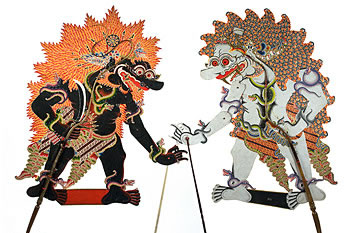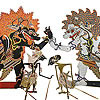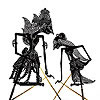Wayang Purwa: Repertoire and The Cast Of Characters
The term wayang purwa refers to four cycles of epics, which began to be standardized by the royal courts of Central Java in the eighteenth century. The two most popular and commonly performed of these epics are the Mahabharata and Ramayana.
Wayang stories involve moral and ethical dilemmas faced by the characters in their journeys through life, love, and war. The stories are about good versus evil, but more than that, they contemplate the existential struggle between right and wrong. They are about the pursuit of living a virtuous, noble life and the search for meaning. The means to those ends are not always clear cut. “Good” characters may posses certain negative traits and likewise, not all the “bad” characters are entirely immoral. Whatever the circumstance, wayang stories always present philosophical ideas and poignant messages.
Historic Roots
The Hindu stories, Mahabharata and Ramayana, originated in India possibly as far back as the eighth century BCE and reached Java around the eighth century CE. For centuries, Hinduism was the predominant religion of Java. Over time, the epics became distinctly Javanese versions of the original Indian texts and by the tenth century they were recited in the form of wayang kulit as court-based theater. Most likely, the Hindu stories were applied to indigenous beliefs and local shadow puppet traditions, melding into a uniquely Javanese custom.
When Islam took hold in Java (1200 – 1600), the current stylized form of wayang kulit was adopted to meet cultural prohibitions on representation of the human form. The aesthetic traits of the puppets persist and Islam’s presence on Java remains strong, while the Hindu body of literature continues to be an important part of Javanese art and culture to this day.
The Epics
The epics are divided into over 200 distinct and autonomous, yet related episodes (lakon), which are the stories presented in singular, nine hour performances of classical wayang kulit in Central Java.




